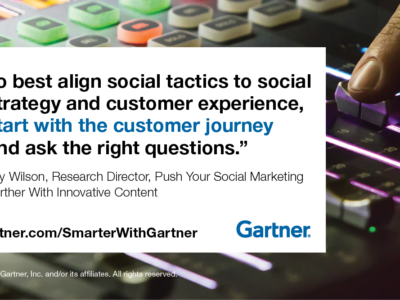Learn how social marketing contributes to the path-to-purchase funnel by building the right attribution model.
Social marketing is a top investment tool for companies, yet beyond metrics like reach or engagement, decision-makers struggle to pin down ROI. At one large marketing software-as-a-service provider, the CMO believed that social marketing impacted lead generation. But when the company modeled close rates, social marketing actually had a bigger impact on closing business by helping potential customers feel better about their choices.
Developing a revenue attribution model is complex. It typically involves rigorous data analysis and trial and error, and requires a sustained commitment from leadership. But, the results are worth the effort.
“Social marketing attribution provides insight into the role that social marketing plays along the path to purchase,” noted Jennifer Polk, research director for Gartner for Marketing Leaders. “Specifically, it can determine the impact of each social marketing tactic, content or social networking site on a defined goal.”
Building an attribution model yields a clearer picture of social marketing’s broad contribution to the path-to-purchase funnel (for example, how engagement affects customer retention), as well as the relative success of different components (for example, how that customer retention impacts revenue).
Begin with leadership
To get stakeholders on board, begin with a full commitment from corporate leadership, and choose one high-level manager to serve as sponsor. Project managers – preferably from outside the day-to-day social marketing team — will be tasked with analytical and modeling efforts, for both structured data (e.g., sales) and unstructured data (e.g., social posts).
What type of data do you have?
The first step in building a user-level attribution model is to determine what data you have and what additional data you can access. Outside technology and service providers that are hired to help with the models will also require access to critical data
There are three types of attribution methods:
- Business Rules — Assigns weight or value to events like first click or last click. This method is the easiest to implement and understand, but lends itself to unscientific and potentially misleading results.
- Algorithmic – Models an event’s contribution by isolating each event and comparing success rates when it is present or absent. This is more accurate, but it can be difficult to link social identity to customer ID, thus to tie marketing to sales.
- Causal — This determines a cause-and-effect relationship between social events and goals. While it is most likely to produce accurate insights, it is costly and difficult to scale.
The revenue attribution model you choose will determine the data you need and the type of data modeling and analysis required. Concentrate on measurement that illustrates the role of social marketing.
To find out more about the three types of attribution methods visit Smarter With Gartner website.
Gartner for Marketing Leaders clients can learn more in How to Determine Social Marketing Revenue Attribution.










